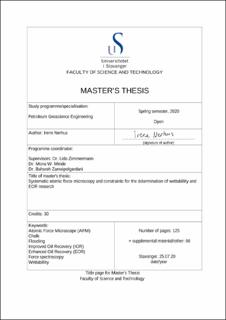| dc.description.abstract | A highly attractive strategy within the hydrocarbon industry is improving the percentage of recovery from the reservoirs, called Improved Oil Recovery/Enhanced Oil Recovery (IOR/EOR). The Atomic Force Microscope (AFM) is a tool that can help understanding the surface and forces on the surface of a mineral or a specific material. The presented application of an AFM to hydrocarbon-related research is a rather novel study approach with restricted knowledge on beforehand. Hence, a major part of this study has been focused on general and introductive work in developing a methodology to determine certain characteristics of the grains. Rock-fluid interactions are a central part of EOR techniques using flooding of rock formations. Thus, this project was defined to test the applicability of an AFM for EOR research.
The studied samples are mostly chalk from Denmark and Belgium of Cretaceous age, both flooded and unflooded by specific fluids related to EOR research. Chosen mineral standards were kindly provided from the Department of Mineral Sciences, Smithsonian Institution for the sake of comparisons.
Topographic measurements indicate similar surface topography and morphology of most of the samples. However, some minerals in certain samples displayed differences. Magnesite in samples LTT1 and ULTT, chalk flooded with MgCl2, reveal a more step-like structure than other minerals which had mainly rounded shapes with smooth edges. Other samples, LTT1, OBSV4_1, OBSV12_6 and OBSV18 disclose lath-shaped and rounded phases appearing on flatter surfaces of calcite and magnesite, interpreted to be clay. The interpreted new grown phases after flooding have a height of approximately 40 nm and grow mainly on top of the existing mineral grains, more towards the edges of the flooded core than the mineral. This may be an important feature in differentiating some carbonate minerals, but further studies are necessary.
Force spectroscopy results indicate both repulsive and attractive forces on the surface of the minerals. Ilmenite, magnesite, magnetite, and quartz indicate both attractive and repulsive forces in the area (5 x 5 micron) of the same mineral. However, anorthite, calcite, dolomite, and magnesite, in some samples, exhibit only attractive force, while fluorapatite and plagioclase display only repulsive force. This feature may be used to identify specific minerals as new grown phases. However, it has to be studied in advance, which minerals that are expected to grow, and have similar characteristics.
These results together shed lights on the need for more knowledge regarding this tool, as well as the importance of studies for further use. Nonetheless, the results are very promising as they can demonstrate different characteristics measured by the AFM as a consequence of the chemical composition of the phase. Changes of chemical compositions and forces at the surface are definitely parameters that affect wettability, which in turn, are of highest interest for the hydrocarbon industry. Sample preparation is essential, and within a longer research study, different approaches can be tested. Further studies should therefore include different preparations, as well as a variety of samples to gain more insights in the relationship of adhesion related to wettability and as well tests performed in liquids. | en_US |

